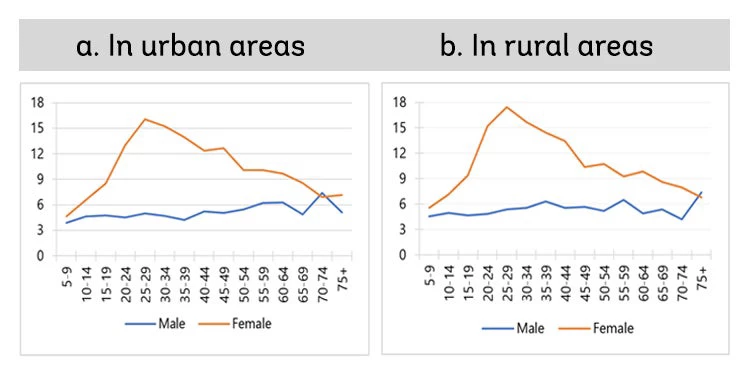 Rural women returning from a fruit harvest in Kouandé, an area in northern Benin.
Rural women returning from a fruit harvest in Kouandé, an area in northern Benin.
Being born a woman in Benin doesn’t come with the same opportunities as being born a man. Being born a rural woman limits one’s prospects even further. The Country Gender Assessment presents a comprehensive overview of gender disparities across different domains: endowments (health, education), economic opportunities and agency (the ability to make decisions and act on them); the report builds on analysis of the most recent data available to draw a picture that shows progress in several domains – and yet, still significant gaps to tackle in coming years.
Figure 1: Literacy in Benin, by gender, and region

For instance, only 39.6%1 of women are literate, compared to 63.1% of men, yet women’s literacy has improved substantially since 2012 (up from 22.1%).
While the gender gap in literacy is smaller for younger cohorts, gaps remain, and are particularly large in secondary school due to early dropout among girls: completion rate of 39% at secondary school versus 51% of boys. On reproductive and sexual health, adolescent fertility persists: In 2017, 20% of women aged 15-19 had already started their reproductive life.
Level of education, income, area of residence influence adolescent fertility rates. Fertility is higher among adolescent girls living in rural areas (124 per 1000) versus urban areas (87 per 1000). Importantly, between 1996 and 2017, the median duration between two births among girls 15-19 years decreased from 32.6 months to 27.5 months which could imply an increase in fertility in general and in the medium term, counteract poverty reduction efforts.
Women have limited decision-making capacity at home as well as in economic and political bodies. They have less access physical or financial assets and are underrepresented in political bodies. There is an urgency to act, especially with respect to the multiple forms of gender-based violence that women and girls are exposed to. 31.7% of women aged 20 to 49 were already in a union before the age of 18 (DHS 2017). Four in ten ever-partnered women have experienced domestic violence from a partner at any time and 32% have suffered some form of domestic violence in the past 12 months. Tolerance for wife beating is high: 32% of women and 16% of men declare that it is justified for a man to beat his wife or partner for minor reasons.
On economic opportunities, the labor force participation (LFP) rate of women was still lower than that of men by at least ten percentage points. Plus, while women’s LFP has grown considerably from 57% (1990) to 69.3% (2019) they are mostly employed in the informal sector at 95.5% compared to 86% among men. This is also due to their role as caregivers and their socially assigned responsibility for unpaid domestic work: Market economic activities occupy more of men’s time (5.8 hours vs 4 hours for women) while domestic activities take up more of the time available to women (4.2 hours vs only .5 hour for men). Men also enjoy more social activities (2.3 hours) if compared to women (1.5 hour).
Figure 2.1: Hours devoted to housework and child or elder care during the week

Figure 2.2: Hours devoted to shopping at the market, fetching water, fetching wood during the week

Women and girls in rural and remote areas are even more vulnerable – given the absence of income generating activities, distance or absence of services to support them and more traditional social norms that undermine their empowerment and access to opportunities even further.
The World Bank is committed to support Benin in tackling gender inequalities through a series of reforms in Development Policy Operation, gender-based projects (SWEDD), and technical assistance to the National Statistics Institute to improve gender statistics2.
Stay tuned for more.
1 2018/19 “Harmonized household living conditions survey” implemented in the eight West Africa Economic and Monetary Union (WAEMU) member States.
2 With funding from the Bill and Melinda Gates foundation.



Join the Conversation